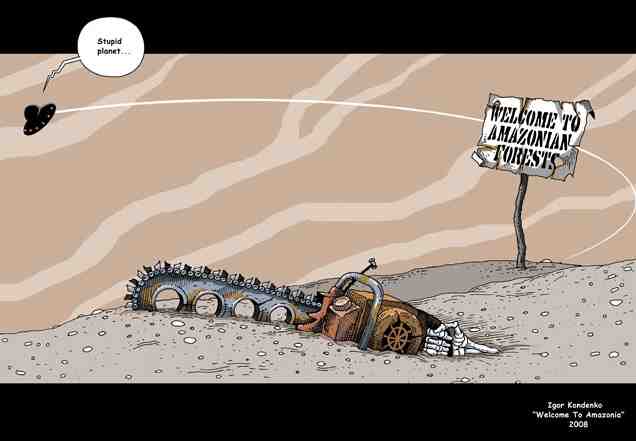 By Stephen Leahy
By Stephen Leahy
It’s well past time that people began to connect the dots between what they buy and the resulting environmental impacts such as global warming. In other words, consumption has consequences: big, nasty environmental consequences that inflict suffering mainly on the world’s poor experts say.
(IPS) (Originally published Jan 15 2007)
A Chinese-made $50 computer desk is likely the result of illegal clear-cutting in Indonesian rainforests. Buying such items fuels crime syndicates and emits huge amounts of global warming gases.
That North Americans, and to a lesser extent Europeans, are profligate consumers is well known. If everyone consumed like North Americans we’d need five planets to support us — only three planets are necessary if we all lived like Europeans, according to the World Wildlife Fund’s Living Planet Report.
The world collectively overshot the Earth’s capacity to support us in 1984, the report notes. In the 22 years since reaching that crucial tipping point, rates of consumption of resources have accelerated. Not just in North America and Europe but China and India, not to mention other parts of Asia and Latin America.
While this ever-accelerating consumption of resources the sign of a healthy global economy according to economists, it has also resulted in climate change, amongst many other environmental and social ills.
“People don’t appreciate that their purchases have real environmental impacts,” said Monique Tilford, acting executive director of the Centre for a New American Dream (CNAD), a Maryland group promoting environmentally and socially responsible consumption.
“They also don’t think their individual actions make much of a difference,” Tilford told IPS.
A Chinese-made computer desk that can be bought for 40 or 50 dollars at a U.S. or European retail store is likely to be the product of illegal clear-cutting in Indonesian rainforests. Such clear-cutting not only fuels crime syndicates, it results in the loss of biodiversity, releases huge amounts of carbon dioxide into the atmosphere and drives indigenous people off their lands.
“We need to shift people to become environmentally and socially conscious consumers,” said Tilford.
That means buying less stuff, and also being willing to spend more on products that are better for the environment or societies in other countries.
“And for those willing to be more conscious, they often don’t have the knowledge or information to know what’s better and that’s the role of NGOs like ours,” she said.
CNAD started a Responsible Purchasing Network for state and local governments in 2000 which has been successful in creating a large market for environmentally-friendly products, Tilford said.
“It is very complicated for public to know what’s from where or how products in the stores are made,” noted Lester Brown of the Earth Policy Institute, a U.S. group focused on environmentally sustainable economy.
China makes about one-third of the world’s furniture, quite surprising in a country that strictly protects its few remaining forests. Imports of foreign timber have skyrocketed and are well over 40 million cubic metres per year. Reports show that re-exports of forest products from China to the United States and Europe have increased by about 900 percent since 1998.
“Scarcity quickly crosses national boundaries,” Brown said in an interview. “If the Chinese furniture makers can’t get trees in China, they get trees from Siberia, Myanmar, Papua New Guinea and Indonesia.”
Greenpeace, Global Witness and other NGOs have documented extensive illegal logging operations in these countries, with China the main receipt of the illegal timber.
— For full story click Charging Towards the Big Melt
My Related articles: 57 Tips On Going Green and Saving Money
new blog: Green Tips for the 21st Century
Economics Killing Mother Nature
Questions, story ideas, potential assignments, speaking engagements contact: writersteve AT gmail . com (no spaces)

How can you tell for sure that there’s any connection between human behaviours and climate change? How can an human being at least think to change the world’s climate?
The energy to make things and move them around comes from the burning of fossil fuels which puts gigatonnes of carbon dioxide into the atmosphere. All that extra carbon has already produced a 1 degree C warming which will become a 2 and perhaps 4.5 C global avg temp increase in 30 or 40 years according to the International Panel on Climate Change. See Climate Panel Report Called Too Conservative
[…] Consumption, Consumerism and Global Warming – Connecting the Dots […]